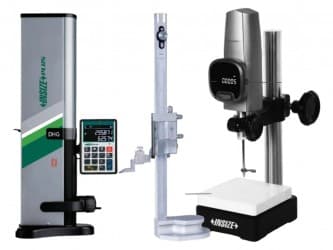Measuring Gauges
These measuring gauges are indispensable tools for ensuring
accurate measurements in various applications, including machining, automotive
repairs, woodworking, and metalworking. Proper care and storage are necessary
to maintain their accuracy and prolong their lifespan.
Certainly! Here are some commonly used measuring gauges:
1.
Measuring Gauges: Measuring gauges, also known as gap gauges or
thickness gauges, are used to measure the gap or clearance between two surfaces
or to determine the thickness of materials. They consist of a set of thin, flat
blades or leaves of various thicknesses that are stacked together. Each blade
is marked with its thickness, allowing users to select the appropriate blade
that fits the gap or measures the desired thickness.
2.
Feeler Gauges: Feeler gauges are precision measuring tools used
to measure the gap or clearance between two parts. They consist of a set of
thin, flexible blades of varying thicknesses. The blades are inserted into the
gap, and the user selects the blade that fits snugly without excessive force.
Feeler gauges are commonly used in automotive, machining, and mechanical
applications.
3.
Hole Gauges: Hole gauges, also known as bore gauges or
telescopic gauges, are used to measure the internal diameter of holes or bores.
They typically consist of two or more telescoping rods or cylinders that can be
adjusted to fit the size of the hole. The gauge is inserted into the hole, and
the rods are expanded until they make contact with the hole walls. The
measurement is then read from the scale on the gauge.
4.
Drill Gauges: Drill gauges, also known as drill bit gauges or
drill size gauges, are used to determine the size or diameter of drill bits.
They have a range of holes or slots of different sizes that correspond to
standard drill bit sizes. By inserting a drill bit into the appropriate hole or
slot on the gauge, the user can quickly identify the size of the bit.
5.
Wire Gauges: Wire gauges, also known as wire diameter gauges or
wire thickness gauges, are used to measure the diameter or thickness of wires
or other cylindrical objects. They typically consist of a set of notches or
slots of different sizes that correspond to specific wire gauges or
thicknesses. The wire is inserted into the appropriate slot until it fits
snugly, and the corresponding wire gauge or thickness is read from the gauge.
6. Screw Pitch Gauges: Screw pitch gauges, also known as thread pitch gauges or pitch measurement gauges, are used to measure the pitch or thread density of screws or bolts. They consist of a set of blades or wires with teeth or grooves of various pitches. The blades or wires are placed on the screw threads, and the one that matches the pitch is selected. Screw pitch gauges are essential for identifying thread types and determining compatibility between different fasteners.





